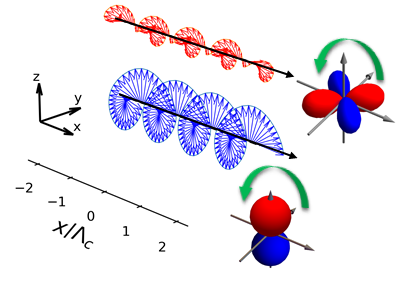Spontaneously Sliding Magnetic Waves Unveil a Dissipative Time Crystal in Laser-Driven Atoms
A collaboration between the Optics Division of the Department and the Institut de Physique de Nice from the Université Côte d'Azur observed spontaneously drifting magnetic stripes in laser-driven Rubidium atoms, demonstrating a novel transport process in out-of-equilibrium magnetic systems. The drift direction and chirality of the waves result from spontaneous symmetry breaking. This phenomenon represents a drifting dissipative space-time crystal, a novel state in many-body systems. It is observed in the ground state of laser-cooled Rubidium atoms exhibiting spontaneous magnetism through light-mediated interactions under optical feedback from a retro-reflecting mirror.
Dipolar and quadrupolar spin density waves are coupled and propagate together in two screws locked together. The coupling between anti-ferromagnetic and quadrupolar ordering shows striking parallels to emerging interest in quadrupolar states in heavy-fermion metals, often related to unconventional superconductivity. However, in condensed matter physics spin density waves and quadrupolar charge density waves do not slide spontaneously but only in a finite amplitude parity-breaking field overcoming pining effects from crystal imperfections. The observation of spontaneous drift in a non-equilibrium version of magnetic ordering can be expected to trigger further fruitful research and insight in the question of time crystals and dissipative time crystals in general and spontaneous spin transport in particular.

April 2024